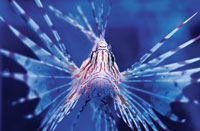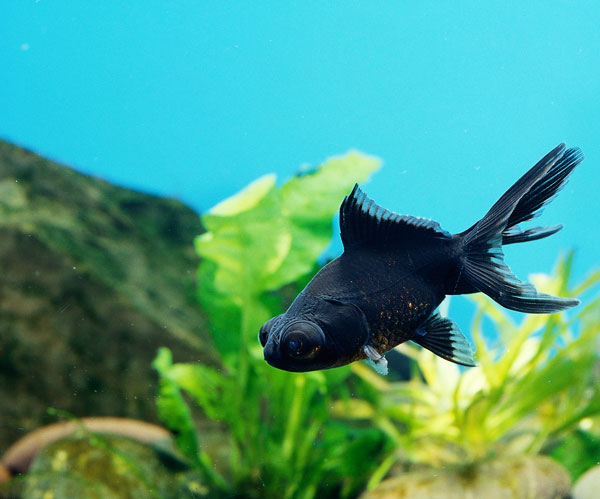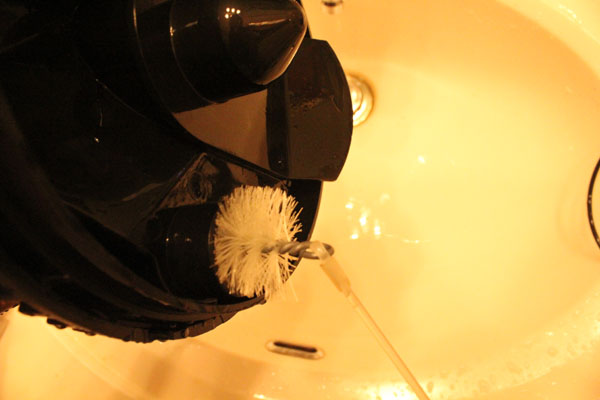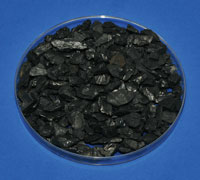
Last column, we discussed invasive species and the potential damage these organisms can cause. In this column, we're going to continue that discussion and focus on several invasive species throughout North America and beyond.
Aquarists get a bad reputation when it comes to aquatic introductions – and some of this is rightly so. However, as we discuss a number of invasive organisms that relate to the aquarium hobby, we'll also discuss their means of introduction, some of which might surprise you. I'll introduce some species, and for each species, go over the area they have invaded, their means of introduction, the effect of the introduction, and exactly how they survive (their “edge”).
 While most people suspect that the lionfish was introduced via the aquarium trade, it has also been suggested that larval lionfish may have hitch-hiked to the Atlantic in the ballast water of large freighters.
While most people suspect that the lionfish was introduced via the aquarium trade, it has also been suggested that larval lionfish may have hitch-hiked to the Atlantic in the ballast water of large freighters.
The Goldfish
Area Invaded: The goldfish is native to Southeast Asia, and possibly parts of Europe. Beyond that, it’s now invasive essentially everywhere. It is found throughout the U.S., Canada, Mexico, and well beyond.
Means of Introduction: Goldfish are commonly released by aquarium keepers seeking to free their pets. (I once met a school teacher who planned on imitating a certain movie, by having each of her children release a goldfish into a stream!) They are often also used (illegally) for bait. When placed in ornamental ponds, they can often escape, either during flooding, or carried by other animals.
Their Edge: Goldfish are able to survive in fairly poor water conditions, and are able to handle wild fluctuations in water quality that other fish can't handle. They are remarkably tolerant of pollution. They also produce copious amounts of offspring, and can reach a relatively fair size.
Impact: Goldfish are eating machines. They forage in the bottoms of lakes, ponds, streams, and any other body of water, where they feast on aquatic vegetation, depriving other organisms of food. Further, their “rooting” activities can muck up a good body of water, decreasing dissolved oxygen, increasing turbidity, and effectively spoiling it for other species. Also, their fatty bodies do not provide a good diet for prey fishes, as many aquarists find out.
Livebearers (Swordtails, Mollies, Guppies)
Area Invaded: The various common aquarium livebearers have been introduced throughout the country, and can be found essentially anywhere where it is warm, including the American Southwest, Florida, and even thermal springs and power plant effluents.
Means of Introduction: Almost universally, these are aquarium releases. In some cases, they have escaped from farming operations. Unfortunately, they are also often stocked to control insect larvae (see below), such as mosquitoes, sometimes by state agencies.
Their Edge: Being livebearers, essentially, is their primary edge. They reproduce quickly, and have large, hardy young that outcompete our native egg layers.
Impact: Most of these fish are omnivores. They gobble up periphyton that other fish rely upon. They may eat small fry from other species. They also eat huge numbers of plankton and insects, which other aquatic organisms rely upon. Livebearers have been directly linked to the decline of several species of dragonfly – an animal that eats mosquitoes. They have been shown to outcompete native, critically endangered pupfishes for habitat in many areas, as well.
Hydrilla
Area Invaded: Throughout the United States.
Means of Introduction: Unfortunately, hydrilla was brought to this country in the 1950s as an aquarium plant. Ironically, it takes a keen eye to tell it apart from our native Anacharis (Elodea Canadensis). Plants were discarded from aquariums into public waterways, or were used in ponds and transported. The plant is easily spread by watercraft, fishermen, and the like.
Its Edge: Hydrilla is inedible. Like many other aquatic plants, it has predators, but since the plant is not native, the predators are not here.
Impact: Hydrilla, simply put, takes over. Waterways which are affected soon become choked by the plant. Fish that rely on open habitat die off. Fish that rely on rocks, crevices, gravel, and the like cannot find habitat in weed choked areas. Dissolved oxygen may plummet overnight as the plants use it up, and autumn die offs can severely effect nutrient cycling. Waterways are not available for recreation.
Note: I could easily retype the entire section above using “Eurasian Milfoil,” or any other number of aquatic plants. Ironically, many of our invasive aquatic plants have a near-twin in our native plants. They're used for aquariums or ponds, and they manage to escape into the wild. Once there, they're often impossible to eradicate, without destroying entire ecosystems.
Malaysian Trumpet Snail
Area Invaded: Florida, Texas, California.
Means of Introduction: Disposal of aquarium pest.
Its Edge: The Malaysian snail burrows down into the mud and muck, making it hard for any predators to get them. Their tight, hard shells with their familiar trumpet shape are also hard for many predators to access. Plus, they're livebearing – they give birth to miniature snails, complete with hard to crack shells.
Impact: Ever have a planted tank get taken over by these guys? Imagine that in a stream. Or a pond. Essentially, anything other than the trumpet snail that eats algae is out of luck.
The Lionfish
Area Invaded: Atlantic Coastal U.S.
Means of Introduction: While most people suspect that the lionfish was introduced via the aquarium trade, it has also been suggested that larval lionfish may have hitch-hiked to the Atlantic in the ballast water of large freighters. This is a common means of introduction for many species, and is plausible. However, Occam's Razor states that the aquarium trade is likely to blame (see note).
Its Edge: Lionfish sting. Their sting protects them from many predators. Plus, they're incredibly well camouflaged.
Impact: Lionfish are eating machines. While the lionfish is the most recent introduction on this list, reports are already coming in of areas where they're remarkably common – and where forage fish are few and far between.
Note: The lionfish belongs to an informal group of aquarium fishes that have the dubious honor of being large, predatory fishes now found invasively in the American waters. Essentially any large cichlid can be included in this list, most notably the Oscar.
The list of invaders in our waters goes on and on, and can easily be expanded. I could write columns similar to this one for the next five years and never repeat a species. Next month, in the final part of this arc, we'll look at some of the control methods used to remove exotic species, and how you can get involved. We'll also take a hard look at the best control method – prevention. We can prevent more invasive species from finding our waters.
 Fish and Fungus
Black Moor Q. I have two large black moor goldfish, one larg
Fish and Fungus
Black Moor Q. I have two large black moor goldfish, one larg
 How to Maintain Your Aquarium Filter
Aquarium filtration saw monumental advances in technology du
How to Maintain Your Aquarium Filter
Aquarium filtration saw monumental advances in technology du
 Canister Filters
In this article we will deal with a type of filter that many
Canister Filters
In this article we will deal with a type of filter that many
 Would You Like The Supreme Fishing Experience? Heres The Reason Why It Is Essential To Carry The Mo
If what youre seeking out is considerably more fish thr
Would You Like The Supreme Fishing Experience? Heres The Reason Why It Is Essential To Carry The Mo
If what youre seeking out is considerably more fish thr
 Aquarium Carbon
Whether it is for a small betta bowl, 6 million gallons
Aquarium Carbon
Whether it is for a small betta bowl, 6 million gallons
Copyright © 2005-2016 Pet Information All Rights Reserved
Contact us: www162date@outlook.com